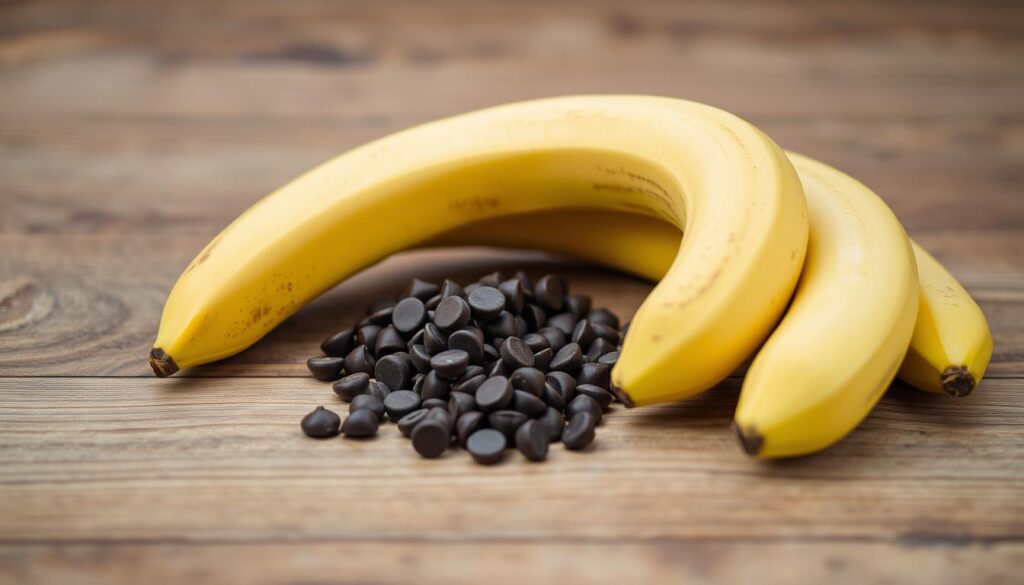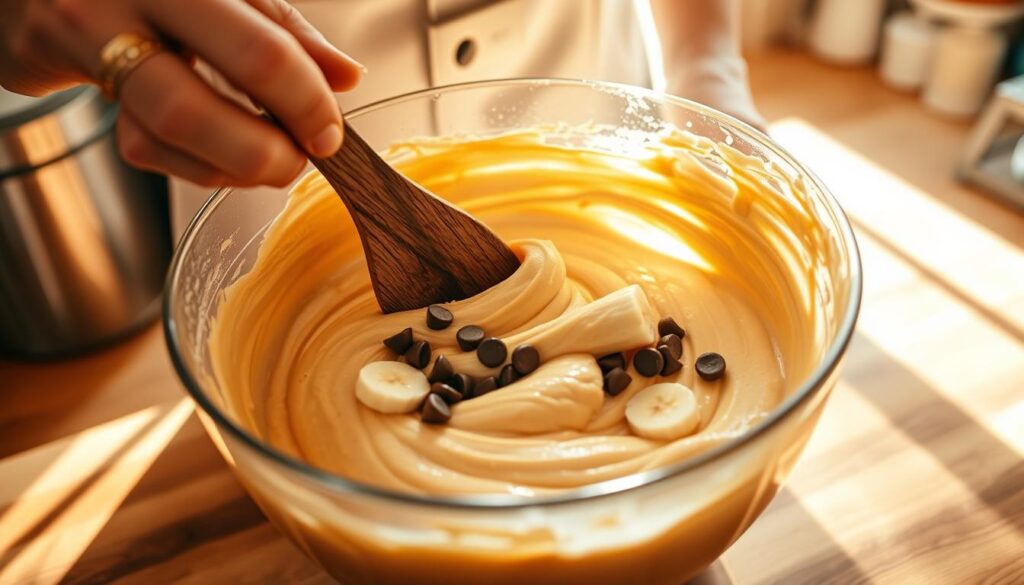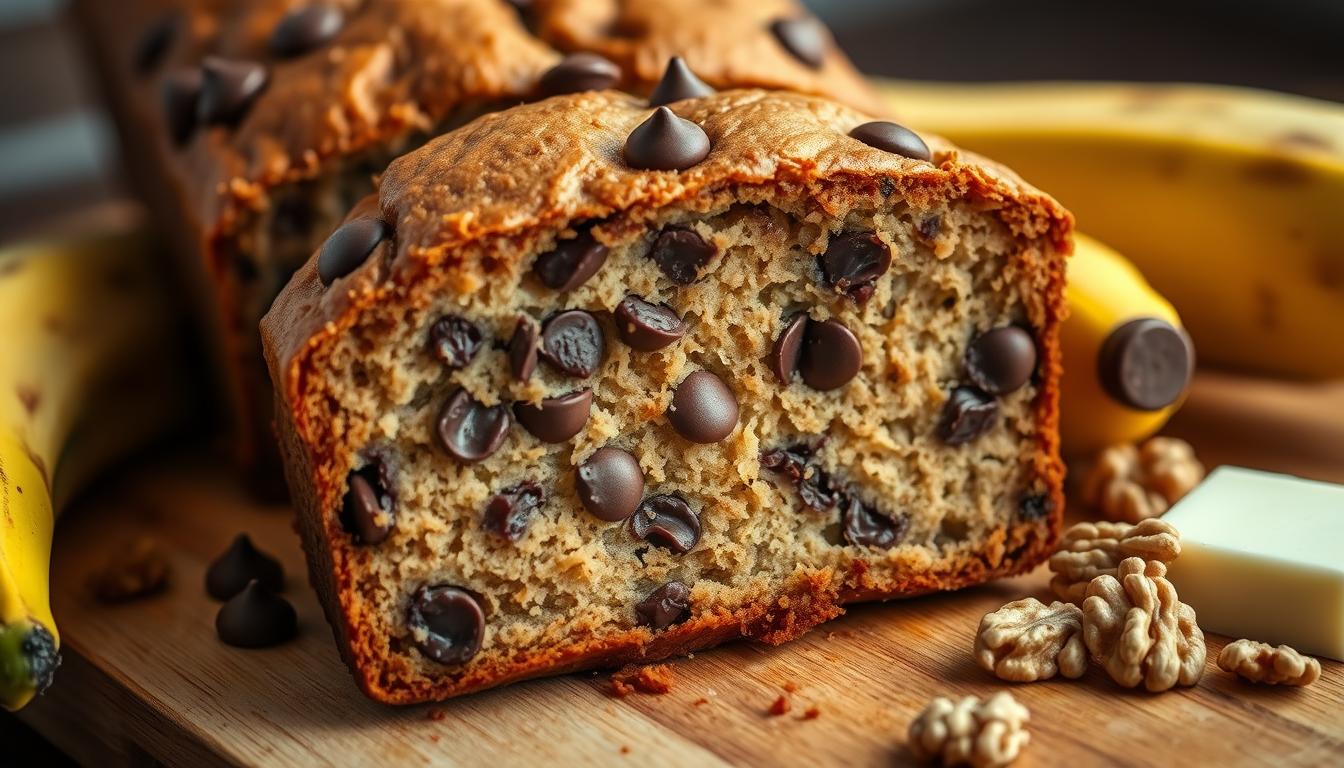The Best Chocolate Chip Banana Bread Recipe for a Gooey Treat
What if your go-to baked treat could be both moist and decadent without hours in the kitchen? Most versions of this classic comfort food fall short—either too dry, overly dense, or lacking that melt-in-your-mouth quality. But what separates a forgettable loaf from one that keeps everyone reaching for seconds?
Craving a delicious dessert? Try our chocolate chip banana bread recipe for a moist and gooey treat, perfect for satisfying your sweet tooth.
This guide reveals the secrets to crafting a golden-brown loaf with a tender crumb and pockets of gooey richness. You’ll learn why ingredient ratios matter more than you think, how overripe fruit transforms texture, and why a single tweak can elevate your results from “good” to unforgettable.
We’ll break down the science behind achieving that perfect balance—think crispy edges paired with a soft interior. Discover how to avoid common pitfalls, like uneven baking or bland flavors, while maximizing every sweet, melty bite.
Key Takeaways
- Why precise measurements ensure a consistently perfect texture
- How fruit ripeness impacts moisture and sweetness
- The ideal flour-to-fat ratio for a tender crumb
- Step-by-step tips for even mixing without overworking the batter
- Science-backed tricks to prevent a soggy or dry outcome
- Creative ways to adapt the base formula for dietary preferences
- How to balance rich flavors without overwhelming the palate
Introduction to This Delicious Banana Bread
There’s a reason this version has become a favorite among home bakers. Unlike traditional quick breads that dry out quickly, every slice here stays soft for days while delivering bold, natural sweetness. The magic starts with fruit at its peak ripeness and a few smart ingredient swaps that lock in moisture.
What Makes This Recipe Stand Out?
Overripe fruit isn’t just a suggestion—it’s essential. Those speckled peels hold concentrated sugars and moisture that transform ordinary loaves into something extraordinary. Combined with melted butter (not softened), the batter develops a velvety texture that bakes into a tender crumb.
Two unexpected additions elevate this formula:
- Greek yogurt adds subtle tang while preventing dryness
- A single-bowl process minimizes cleanup without sacrificing consistency
You’ll notice the balance immediately: rich pockets of melted goodness contrast with the earthy sweetness of the base. Unlike overly dense versions, this stays light yet satisfying. The secret? Precise ratios of wet to dry ingredients that maintain structure without heaviness.
Best of all, it adapts effortlessly. Swap in alternative flours or reduce sugar slightly—the forgiving nature means you can tweak without fear. Whether served warm or days later, each bite remains as inviting as the first.
Essential Ingredients and Equipment for Baking
Quality ingredients paired with the right tools make all the difference between a good bake and an exceptional one. Let’s break down what you’ll need to create that perfect balance of flavors and textures.

Choosing the Best Ripe Bananas and Chocolate Chips
Your fruit should have deep brown spots and feel soft when pressed. These ripe bananas mash easily, blending into the batter for natural sweetness and moisture. Avoid firm, yellow ones—they lack the concentrated sugars needed for rich flavor.
For the chips, semi-sweet varieties complement the fruit’s sweetness without overpowering it. Mini versions spread evenly, while standard-sized pieces create gooey pockets. Need more control over sweetness? Use this guide:
| Type | Sweetness Level | Best For |
|---|---|---|
| Semi-Sweet | Balanced | Classic flavor |
| Milk | High | Extra sweetness |
| Bittersweet | Low | Sophisticated taste |
Must-Have Kitchen Tools and Loaf Pans
A 9×5-inch metal loaf pan ensures even baking and proper rise. Grease it thoroughly to prevent sticking. You’ll also need:
- A sturdy mixing bowl for combining ingredients
- Measuring cups to maintain precise ratios
- A fork or potato masher for creamy fruit pulp
These tools streamline prep work while ensuring consistent results. Remember: the right equipment eliminates guesswork, letting the ingredients shine.
Preparing Your Ingredients for Optimal Flavor
The secret to a perfectly textured loaf starts long before the oven preheats. Proper ingredient preparation ensures even mixing and consistent baking results. Let’s explore how simple adjustments in your prep routine can elevate your final product.
Room Temperature Essentials: Eggs, Butter, and Bananas
Make sure your eggs, butter, and fruit sit at room temperature before mixing. Cold ingredients create uneven textures—think dense spots or separated batter. Warm components blend seamlessly, forming a velvety base.
Need to warm eggs quickly? Submerge them in warm water for five minutes. Forgot to soften butter? Grate it using a cheese grater—it’ll reach the ideal consistency in minutes. This trick works better than microwaving, which often melts parts unevenly.
Thawed bananas require special care. If using frozen ones, let them drain completely after thawing. Excess liquid throws off moisture ratios, leading to gummy results. Room-temperature fruit mashes smoothly, distributing sweetness evenly without clumps.
Why does this matter? Butter at the right temperature traps air when creamed with sugar, creating lift. Eggs emulsify better, binding fats and liquids. Bananas integrate fully, avoiding pockets of raw flour. These small steps ensure your batter bakes uniformly from edge to center.
Mastering the Batter: Mixing and Folding Techniques
The difference between a good bake and a great one often comes down to technique. How you handle the dry ingredients and incorporate add-ins determines whether your creation emerges light and tender or dense and rubbery.

Combining Wet and Dry Ingredients
Start by whisking flour, leavening agents, and salt in a separate bowl. This ensures even distribution—no bitter bites from clumped baking soda. Pour these into your wet mixture using a wide spatula.
Fold gently using a figure-eight motion. Stop as soon as streaks disappear. “A few lumps are better than overmixed batter,” says seasoned bakers. Overworking the mixture activates gluten proteins, leading to a tough texture.
Folding in the Chocolate Chips for Even Distribution
Reserve 25% of your chocolate chips before adding the rest. Toss them lightly in flour first—this prevents sinking during baking. Use a lifting motion to rotate the batter from bottom to top.
The ideal consistency? Thick enough to hold its shape but still pourable. You should see distinct fruit pieces and chip clusters. Scatter reserved morsels on top for visual appeal and molten pockets in every slice.
Perfecting Oven Temperature and Baking Time
Your kitchen’s heat management determines whether you get a golden crown or sunken center. Ovens vary more than you think—a 25°F difference can turn crisp edges into burnt crusts. Precision here separates reliable bakers from frustrated ones.
Preheating and Pan Preparation Tips
Always preheat for 20 minutes. This stabilizes the oven’s internal environment. Cold spots disappear, giving your creation even heat from minute one. Use an oven thermometer—many dials lie by 15-25°F.
For pan prep, butter every crevice. Dust with flour using a fine sieve. Tap out excess—this creates a non-stick shield without altering texture. Metal pans conduct heat better than glass, promoting that coveted crackly top.
Baking times aren’t fixed. At 350°F, check at 45 minutes. If your oven runs hot (375°F+), start testing at 40 minutes. The toothpick test works best: moist crumbs mean done, wet batter needs 5 more minutes.
Let it rest 10 minutes post-bake. This allows steam to redistribute, preventing collapse when transferring. Cooling racks prevent soggy bottoms by promoting airflow. Patience here ensures structural integrity—no crumbly disasters.
Achieving a Moist, Gooey Texture Every Time
Texture transforms a simple loaf into an irresistible experience. The interplay between three key components determines whether you’ll get dry crumbs or velvety perfection.
Balancing Flour, Butter, and Yogurt
Melted butter acts like liquid gold here. Unlike softened versions, it fully coats flour particles, limiting gluten formation. This creates a tender bite rather than chewiness.
Greek yogurt brings dual benefits:
- Adds moisture without thinning the batter
- Provides subtle tang to offset sweetness
“The harmony between fat and acid creates that melt-in-your-mouth quality every baker craves,” notes pastry chef Elena Carter.
See how these ingredients work together:
| Ingredient | Function | Pro Tip |
|---|---|---|
| Melted Butter | Coats flour proteins | Cool slightly before mixing |
| Greek Yogurt | Boosts moisture retention | Use full-fat for richness |
| Sour Cream | Yogurt alternative | Equal substitution works |
Measure flour correctly—scooping directly from the bag compacts it. Instead, spoon it into your cup and level with a knife. Too much creates dryness; too little leads to collapse.
Humidity affects your batter. On muggy days, reduce yogurt by 1 tbsp. In dry climates, add an extra egg yolk. These tweaks maintain balance without recipe overhaul.
Expert Tips for a Flawless chocolate chip banana bread recipe
Perfecting your technique makes all the difference between a decent loaf and a showstopper. This bread recipe thrives on precision—from measuring mashed fruit to selecting the right pan size.
Avoiding Overmixing and Other Common Pitfalls
Measure mashed fruit precisely—about 1½ cups from 3-4 medium pieces. If you’re short, applesauce fills the gap without altering moisture. Never pack ingredients into cups; this disrupts ratios.
Spoon all-purpose flour into your measuring cup and level it. This prevents dense results from packed dry ingredients. For creaming success, beat butter and sugar until thickened like frosting—it traps air for lift.
Mix by hand once dry ingredients join the batter. A few lumps are fine. Make sure your loaf pan measures 9×5 inches—smaller pans cause uneven baking and a sinking center.
Overworking the batter activates gluten, turning tender crumbs into rubber. Gentle mixing stops strands from forming, ensuring that iconic soft texture. Follow these steps, and you’ll master balance every time.







